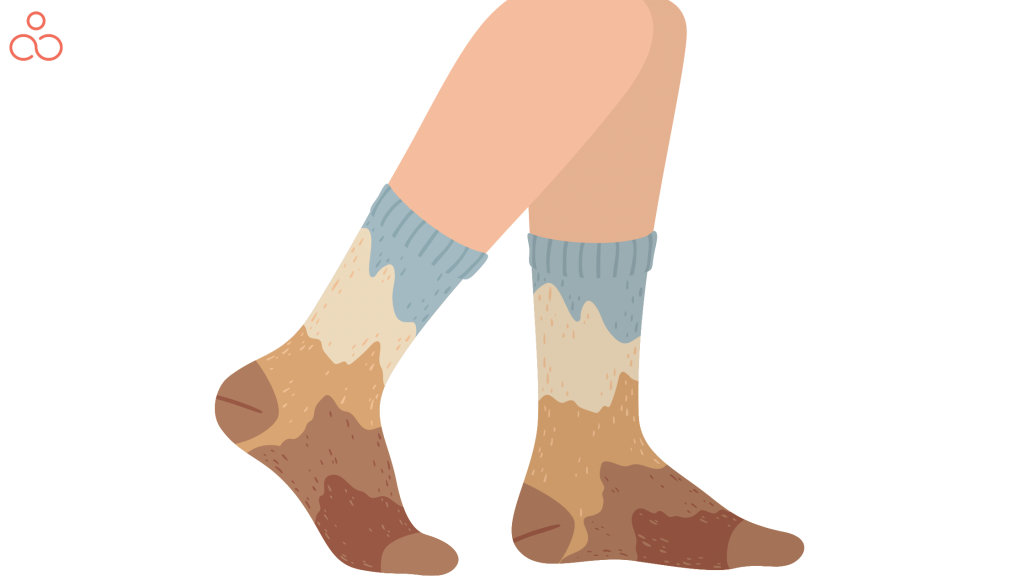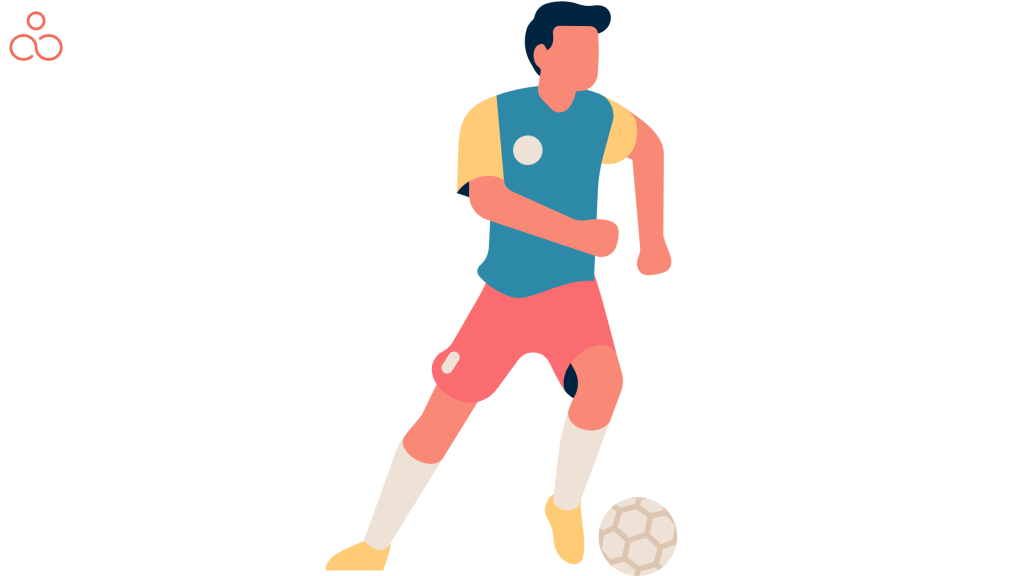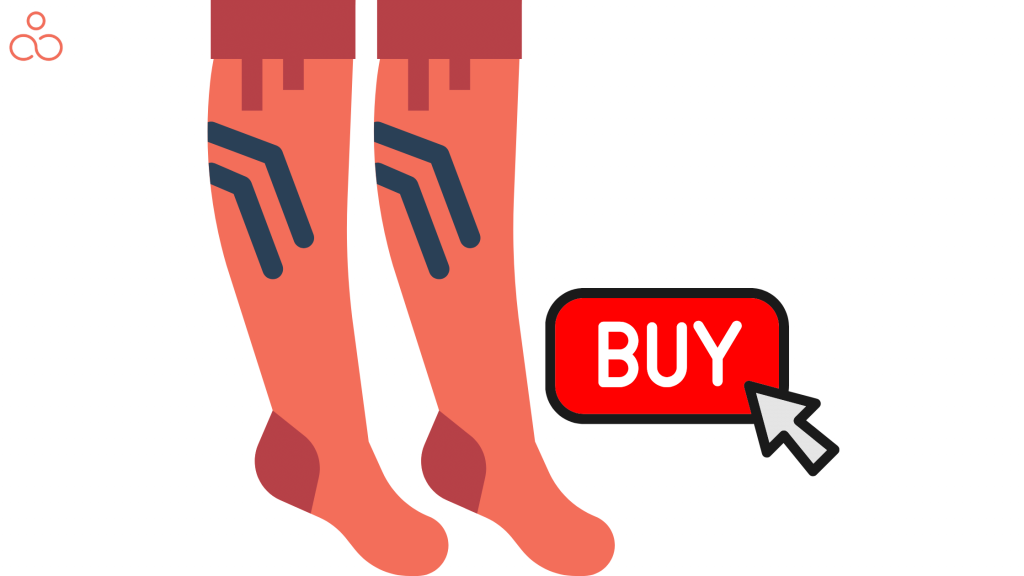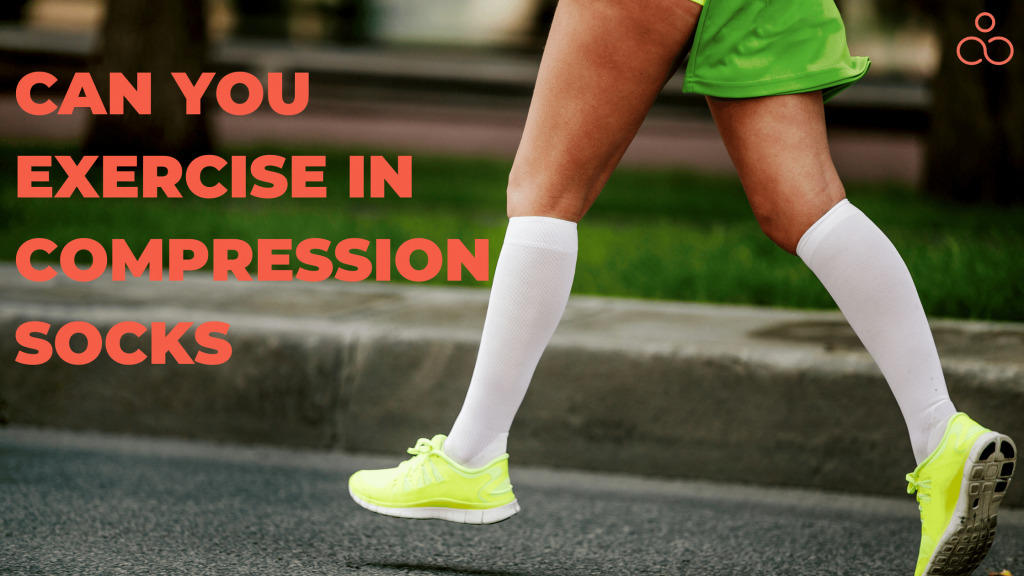Compression socks are all the rage these days. Whether you’re running a marathon or just going for a jog around the block, many people swear by these socks to help them stay comfortable and prevent injury. But can you exercise in compression socks? The answer could be a clearer-cut. Let’s look at the science behind compression socks and how they can affect your workout.
What are compression socks?
Compression socks are often used by athletes, people who stand for long periods, and those with circulation problems. They are made of a stretchy material and fit snugly around the feet and lower legs. They provide graduated compression, meaning that the pressure of the sock is most significant at the ankle and lessens as it goes up the leg. Compression socks are tall sport socks that gently squeeze the calf to compress the veins and muscles in the leg, which helps blood vessels function better and improves blood flow. This enhances circulation, allowing blood to flow more freely from the legs to the heart and preventing blood reflux or clotting. Compression socks can also help to prevent vein problems, such as varicose veins and deep vein thrombosis.
How do compression socks work?

Compression socks are designed to increase circulation in the legs. They gently squeeze the legs to promote blood flow to the lower extremities. Compression socks come in different compression levels: mild, moderate, and firm. The reduction required depends on the individual’s medical condition and needs. For example, those with medical conditions like varicose veins, diabetes, and deep vein thrombosis may require a higher level of compression. Additionally, athletes may also benefit from compression socks, as the increased blood flow helps to reduce fatigue and soreness. Wearing compression socks regularly can help reduce swelling and pain and even aid in recovery from injuries.
When to wear compression socks?
Compression socks are an essential part of a medical treatment plan to prevent varicose veins, reduce swelling from pregnancy, improve circulation, and help prevent deep vein thrombosis. They can be worn during the day or night, depending on the severity of the condition and the doctor’s recommendation. Generally, wearing compression socks during the day is advisable, as this will provide the most benefit. However, wearing compression socks at night is also recommended for those with more severe conditions.
Compression socks for athletes

Compression socks are not just for office workers or for those stuck in cramped economy cabins on long flights- they’re being increasingly used by athletes.
They are also ideal for athletes who require extra support during physical activities. Compression socks can help reduce muscle fatigue, soreness, and swelling, and help prevent injuries such as shin splints and plantar fasciitis. Overall, compression socks can be a great addition to an athlete’s gear to help improve performance and recovery.
Compression socks for regular exercise
Compression socks are an excellent solution for regular exercise, providing enhanced blood flow and muscle support to help reduce fatigue. It can also help to keep your legs warm if you are out for a run. There are also some potential benefits to wearing them while exercising, like helping with swelling and enhancing performance and recovery.
For how long should you wear compression socks?
When it comes to getting the most benefits from compression socks, you need to wear them for at least 6 hours after you’re done with any activity. For activities like marathons that are intense and take longer, wear them for 6 to 12 hours a day and continue wearing them for a few days. You should also change to a new pair after wearing them outdoors. Many factors can affect wearing compression socks outside, as shown in the picture below.
What is the appropriate size of compression socks to purchase?
It is important to make sure that you buy the correct size of compression socks. That is why taking proper measurements of your legs is crucial. The manufacturer’s size chart should be referred to, and it is recommended to measure your legs in the morning when swelling is minimal. It is advisable to go up a size when you are in between sizes. Compression socks are commonly worn to reduce leg swelling, relieve pain, and improve blood circulation. While they are usually recommended for individuals suffering from venous insufficiency or to alleviate varicose veins, athletes worldwide have embraced compression socks and sleeves for their many performance and recovery benefits.
Is it a good idea to don compression socks during or after exercising?
Wearing compression socks during or after exercise is a matter of personal preference. Some people swear by the benefits of wearing compression socks during a workout to help reduce muscle fatigue. In contrast, others prefer wearing them after the exercise session to help reduce swelling and aid muscle recovery. Ultimately, it’s up to you to decide which option is best for your individual needs.
Compression socks during exercise
Compression socks can be beneficial during exercise as they can improve circulation and reduce muscle soreness and fatigue. The socks work by gently squeezing the legs to help the blood flow back to the heart more efficiently. This can result in improved oxygenation of the muscles, which can enhance performance and reduce the risk of injury. Additionally, compression socks can help to prevent swelling and the formation of blood clots, especially during prolonged sitting or standing. Overall, wearing compression socks during exercise can provide a number of benefits for both athletes and non-athletes alike.
Compression socks after exercise
Compression socks are often worn after exercise to help improve blood flow and reduce swelling in the legs. These specialised socks apply gentle pressure to the legs, which helps to squeeze blood vessels and promote better circulation. By improving blood flow, compression socks can help reduce muscle soreness and prevent injuries. Additionally, they can help reduce the risk of blood clots forming in the legs, which can be a serious complication following prolonged sitting or immobility. Overall, compression socks are a great choice for anyone looking to recover faster and improve their overall exercise performance.
10 Benefits of compression socks
Improved performance
The study conducted on a group of 10 people demonstrated that compression socks can help boost performance. Compression socks are a great way to improve your performance and increase circulation in your lower legs. They can help reduce fatigue and soreness, allowing you to push your limits further. Compression gear is an excellent investment for athletes who want to take their performance to the next level.
Improved lymphatic drainage
Lymph is a liquid that cleans body tissues via a self-contained system called the Lymphatic System. Compression socks are an essential tool for improving lymphatic drainage. Wearing them can help reduce fatigue and improve circulation, which can help with a range of medical conditions.
Improved Circulation
Compression socks promote better circulation by applying pressure to your lower legs. This helps to reduce swelling and improve blood flow.
Reduced Swelling
Compression socks can help reduce swelling in the ankles and feet. This is especially beneficial for those who stand or sit for long periods, as well as those who travel by aeroplane.
Treatment for varicose veins
Compression socks are essential for treating varicose veins and other vein problems. They work by applying gentle pressure to the legs, helping to reduce swelling and improve circulation. Compression socks can also help reduce pain and discomfort associated with vein problems and help prevent them from getting worse.
Improved Mobility
Compression socks can help reduce the risk of injury by providing extra support and stability to your ankles and feet. This can help to improve your mobility while exercising or performing everyday activities.
Improved Posture
Wearing compression socks can help to improve your posture. The extra support helps to reduce stress on your lower back and improve your spine’s alignment.
Reduced Muscle Soreness
Compression socks provide extra support to your muscles while performing activities. This helps to reduce muscle soreness and fatigue.
Improved Athletic Performance
Compression socks can also help to improve athletic performance, as they help to reduce muscle fatigue and improve circulation.
Reduced Risk of Injury
By providing extra support and stability, compression socks can help to reduce the risk of injury. This is especially beneficial for those who perform high-impact activities.
Better Recovery
Compression socks can help to improve recovery time, as they help to reduce swelling and promote better circulation.
Increased Comfort
Compression socks are designed to be comfortable and fit snugly, making them ideal for everyday wear.
Versatility
Compression socks are available in various styles, colours, and lengths, making them ideal for multiple activities and occasions.
Drawbacks of compression socks
Compression socks help improve circulation, reduce swelling, and support aching feet and legs. Unfortunately, there are several drawbacks to using compression socks.
They can be challenging to put on and take off
The socks’ tight fit makes it difficult to slip over the feet and calves. Additionally, they can be uncomfortable to wear, especially in hot weather.
They may cause skin irritation or allergic reactions
Compression socks are usually made of synthetic materials, which may cause itching and rashes. Choosing a pair of socks made of breathable and soft fabrics is essential.
They can cause improper blood flow
Too much compression can lead to decreased blood flow and can cause numbness and tingling in the toes. To prevent this, it is essential to select the correct size of socks and to only wear them for a short time.
They can be expensive
Depending on the quality and brand, compression socks are costly. It is essential to research different options and find the most cost-effective pair.
They can cause heat build-up
The tight fit of the socks can cause the feet to become hot, making them uncomfortable. It is essential to choose a pair of socks with breathable materials.
They can cause clogged pores
Tight-fitting stockings can cause sweat and dirt to accumulate in the pores on the feet. This can lead to bacterial and fungal infections. It is essential to keep the feet clean and dry when wearing compression socks.
How are compression socks different from regular socks?
| Parametres | Compression socks | Regular socks |
| Support | Compression socks are designed to provide additional support to your legs and feet. They are made from an elastic material that holds your feet and legs in place, helping to reduce swelling and increase circulation. | Regular socks are usually made of cotton or other lightweight fabrics. They provide a different level of support. |
| Grip | Compression socks often have non-slip grips on the bottom, which helps to reduce slipping and provides additional support. | Regular socks usually don’t have this feature, making them more prone to falling. |
| Flexibility | Compression socks are tighter around the foot and ankle, and the compression gradually gets lighter as you move up the leg. | Regular socks typically have the same tightness throughout. |
| Compression | Compression socks are designed to provide graduated compression, which means that the level of support increases the higher up the leg you go. This helps to reduce swelling and can help with muscle soreness. | Regular socks do not provide this graduated compression, so they don’t provide the same level of support. |
| Fitness | Compression socks are made from various materials, including nylon, spandex, and lycra. These materials are designed to provide a snug fit and help to reduce friction. | Regular socks can be made from various materials. Still, they are usually less durable and don’t provide the same level of support. |
| Style | Compression socks are available in various styles, including knee-high, thigh-high, and ankle-high. | Regular socks are usually ankle-high, but some types can be slightly higher. |
| Benefit | Compression socks benefit people on their feet all day or with circulation problems. | Regular socks are perfect for everyday wear, but they provide a different level of support. |
Similarities between compression socks and regular socks
Compression socks and regular socks have many similarities.
- They are both made from fabric and have the same purpose: To protect and cushion the feet.
- Both types of socks come in various materials and styles, so it depends on the user’s preference.
- Compression and regular socks also come in various sizes and colours, so one can find something to fit their needs.
6 ways to wear your compression socks

Here are six different ways to wear compression socks that can help you get the most out of them:
Traditional Way
Put your compression socks on in the traditional way, starting with the toe and working your way up to the top of the sock. Ensure the heel and toe are fully seated into the sock, and the cuff is around your calf.
Reverse Way
If your compression socks are similar to regular socks, you can put them on reverse. Start with the cuff, and work your way down to the toe. This can help you get a snugger fit and keep your socks in place.
Seamless Way
If you have seamless compression socks, there’s no need to worry about the heel or toe. Slide them on your feet and pull them up to your calves. This can help you get a smoother fit, and you don’t have to worry about the socks bunching up.
Layer Way
If you have multiple compression socks, you can layer them for a better fit. Start with one pair, then put on the other pair. This can help you get a better fit and more support.
Compression Stockings
Compression stockings are similar to compression socks but come up to your knee or thigh. Roll the stocking up like a tube to put them on, then slide it onto your foot. Work your way up to your thigh and ensure the top is firmly in place.
Compression Sleeves
Compression sleeves are a great alternative to compression socks. Start by putting on the foot part of the sleeve and then slide the sleeve up to the calf. Make sure the top of the sleeve is firmly in place and that the material
Can you exercise in compression socks?
Compression socks are great for active people because they can lower the risk of injury and give more support to leg muscles. Compression socks work with your body’s movements and can give comfort and support while you work out. Be sure to pick the right size and compression level for your compression socks. Compression socks can also be good for everyday things like walking, standing or travelling, since they can reduce discomfort from sitting or being in one position for a long time. Compression socks can be good for people who stand or sit for long periods because they can help reduce swelling in the feet and legs. Compression socks are also good for pregnant women, as they can reduce swelling and give more support.
Where to buy compression socks from?

Here are some suggestions for where to buy compression socks:
- Amazon has a wide selection of compression socks available for purchase.
- REI is a retailer that specialises in outdoor gear and equipment, including compression socks.
- Dicks Sporting Goods: Dicks Sporting Goods also sells compression socks.
- Walmart has a selection of compression socks.
- Target also has a selection of compression socks available for purchase.
- CVS has a small selection of compression socks available for purchase.
- Sports Authority sells compression socks.
Tips for you
Here are some tips for choosing compression socks:
Consider the level of compression you need
Compression socks come in different levels of compression, so it’s essential to choose the right level for your needs. If you need help determining what level of compression you need, consult with your doctor or a healthcare professional.
Consider the material
Compression socks are made from various materials, such as cotton, nylon, and spandex. Consider the fabric of the socks and choose the one that best suits your needs. For example, if you want a more breathable option, you may want to pick cotton socks.
Consider the size
Compression socks should fit properly to be effective. Be sure to measure your leg size and choose the appropriate compression socks size.
Consider the style
Compression socks come in various styles, such as knee-high, thigh-high, and ankle-length socks. Choose the style that best suits your needs and preferences.
Consider the price
Compression socks can range in price, so it’s essential to find a pair that fits your budget. Be sure to compare prices and choose the most affordable option.
FAQs
What advantages do compression socks have for better blood flow?
Compression socks can improve circulation by providing gentle squeezing pressure on the legs. This squeezing pressure helps to increase blood flow, allowing more oxygen and nutrients to reach the muscles. The increased blood flow helps reduce swelling, fatigue, and soreness. Compression socks can also help reduce the risk of venous thromboembolism, which can cause serious health problems.
Why is it important to measure before buying compression socks?
Compression socks are a great way to improve circulation and reduce fatigue. Still, they must be sized correctly to be effective. Measuring your calves is the best way to ensure you get the right size. If the socks are too small, they won’t provide the necessary compression to be effective. On the other hand, if they are too large, they may be uncomfortable and slip down. It is important to note that size matters, so taking the time to measure your calves before buying compression socks can ensure you get the best fit and the most benefit from them.
What indicates the proper compression level when making a purchase of compression socks?
When choosing the right compression level for compression socks, it is essential to consider your individual needs and lifestyle. For example, if you are an active person who is always on the go, you may need a higher level of compression to give you the support you need. On the other hand, if you spend most of your time sitting, a lower compression level may be more suitable. The best way to determine the right compression level is to consult your doctor or physical therapist for their recommendation.
Who should consider wearing compression socks?
Compression socks benefit those on their feet all day, such as nurses, athletes, and people working in retail or hospitality. They also help those who stand for long periods, such as those working in factories and warehouses. In addition, compression socks can benefit those who travel frequently, as they can help reduce swelling and discomfort in the legs.
Are compression socks better than regular socks?
Compression socks are better than regular socks for a variety of reasons. They offer superior support and comfort, improved circulation, and better performance. They are also great for people who have swollen ankles or any chronic pain. Compression socks are designed to fit snugly and provide a tight, controlled feeling that can help reduce fatigue and swelling. On the other hand, regular socks may not offer the same level of support and comfort. Ultimately, deciding which type of sock is best depends on your needs and preferences.
Conclusion
Compression socks can be a great tool to help with exercise, as they provide extra support to the muscles and joints. They can also help reduce the risk of injury and improve circulation. For those looking to maximise the benefits of exercise, compression socks can be a great addition to any workout.

